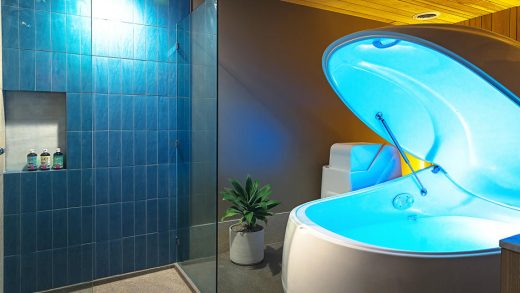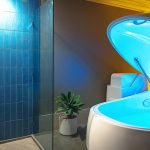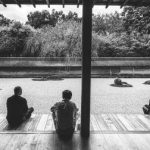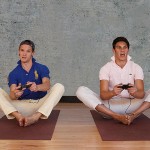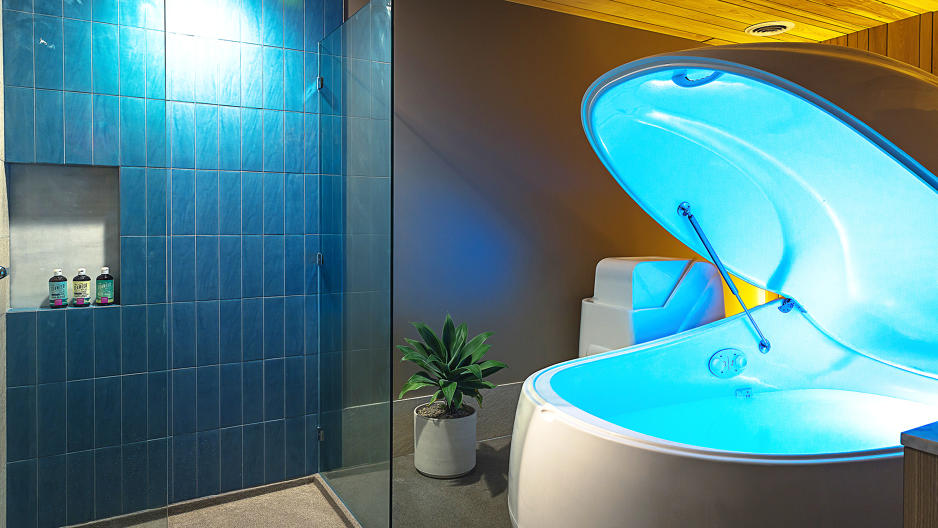Meditation Retreats? Please. Now It’s All About Floating In The Dark
Why not just take a long bath?
That was my biggest question as I readied to go “floating,” the latest wellness fad.
A flotation tank is a human-sized bathtub with a retractable lid that’s filled with 160 gallons of body-temperature water and salted with 1,000 pounds of magnesium sulfate. The mineral, studies show, helps detoxify the body, reduce inflammation, and ease sore muscles. It is also said to trigger the release of endorphins.
The enclosed structure resembles baby Superman’s Krypton escape pod, if his doomed parents had thought he’d need more of a jacuzzi experience as he traveled down to Smallville. You can wear your swimsuit, but the Pause Float Studio in Los Angeles suggests going nude, since, as the company’s website explains, “Material on the body stimulates the senses.”
Relaxing music and soothing lights add to the experience, but the ideal practice is to decline such options. You are meant to float in the pitch black with only the sound of your thoughts. All of this supposedly relieves stress, sleep issues, and just overall exhaustion from the modern world.
I’ve tried a lot of these fitness trends—aqua cycling, surf yoga, heat-infrared beds—and remain quite skeptical. But I was particularly interested in floating, considering its rapid growth across the U.S. Twenty-five years ago, only three centers existed. Then six years ago, eight opened. And now, in just the last five years, 150 have launched nationwide. The three centers I spoke to all attested to nearly full bookings year-round.
So I floated, and I can report that it does indeed differ from my beloved bathtub experience. For one, the temperature permits one to comfortably stay in for over an hour. But most astonishingly, the pitch-black silence did do something: It got me to stop obsessing over my to-do list and constant resentment of L.A. traffic. It forced me to relax, as if I were weightless in space, and focus on, well, nothing. It wasn’t life changing, but it was hour changing.
And for many, that’s worth a lot.
The New Stress Reliever?
Jeffrey Ono is a 15-year veteran of the health and fitness industry, having served as a marketing executive at companies such as Equinox and The Sports Club/LA. Throughout his time in corporate wellness, he witnessed the gradual—and then rapid—rise of clients embracing both physical and well-being exercises.
“We’re crushed by stress these days,” Ono says. “And we’re finally at that point where the mainstream population is aware of the damage that stress does.”
Four years ago, Ono was trying to figure out how he could parlay the the wellness trend he saw in his clubs into an entrepreneurial venture when he stumbled upon a floating studio while visiting Vancouver. After just one soak, he was hooked. “I felt like I was 15 years younger,” he says.
When he returned to Los Angeles, he tried to convince his wife, then pregnant with twins, to try soaking in a pod. But after surveying the options in their area, she refused: They seemed too hippie and unsanitary for her liking. “It wasn’t consumer friendly,” Ono says.
So he launched Pause Float Studio, which strives to make floating appeal to both the novice and wellness expert. The space is curated with natural unfinished wood and cream-colored furniture befitting an Australian beach house.
“The experience is designed to make people feel comfortable and confident that it’s super clean,” Ono says. A filtration cleansing system gets to work after each soak since bathing in another’s meditation waters might be just a little too zen for some.
Pause was specifically built in an area known as “Silicon Beach,” the Venice Beach tech hub of Facebook, Google, and Snapchat. Ono had those companies in mind when he mandated a complete absence of technology within the studio. While his competitors use iPads or videos for floating orientations, Pause relies on good old-fashioned human interaction. Wi-Fi isn’t even available.
“I really wanted this to be a digital-free space, like a digital detox,” he says. “Floating is about disconnecting, giving yourself a break from 24/7 connectivity.” Ono describes Pause as an oasis from the tech mayhem down the street where frazzled executives can calm their distracted minds—just for a little while.
Romain Gaillard, CEO and founder of The Detox Market, a beauty e-tailer specializing in organic and high-end skin-care products, was initially apprehensive about floating. He recalls thinking, “That’s weird.” He gave Pause a try out of pure curiosity and was surprised at how quickly he got into it.
“I was completely relaxed afterward, like I had a one-hour massage,” he says. “Until you do it, it’s very hard to describe.”
He now goes monthly, almost as a ritual after a long day of tending to his startup. “To be completely disconnected for one hour is quite incredible. It’s very rare you have those moments where you’re just by yourself—no computers or iPhones interfering. It helps reset your mind.”
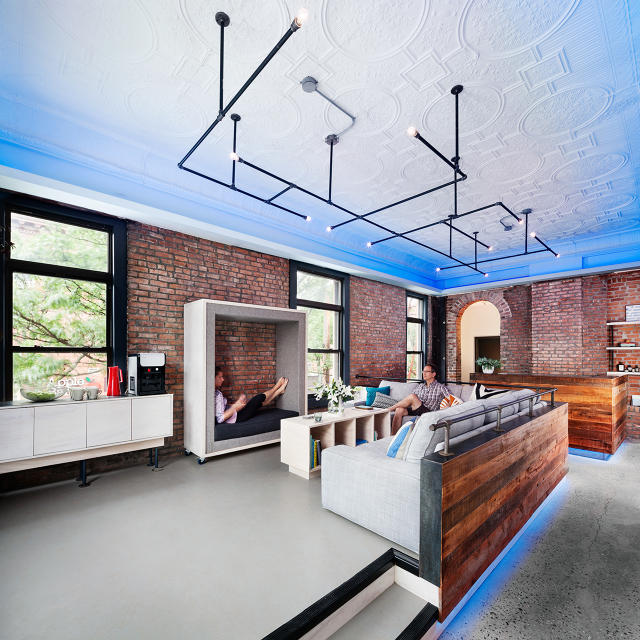
Ono had originally imagined his studio would attract those well-versed in the wellness space, but he’s been amazed to see how many professionals come after their harried days in Silicon Beach. Day after day, he sees the stressed-out technology exec who’s working 80-hour weeks in search of a cure. “They realize they need to give the same attention to recovery as they do to pushing their minds and bodies.”
Floating, it’s been said, works especially well to relieve stress and foster creativity. The detoxification benefits of the magnesium, coupled with the gravity-free environment, is supposed to help the body unwind: It allows your spine to lengthen and uncoil without any restrictions. Then, there’s the elimination of all external stimulation. When there is nothing for the brain to focus on, your system starts to quiet and ultimately wanders into something called the theta mode.
Theta mode is a dreamlike-state in which the right side of the brain opens up and the left side quiets, promoting the free flowing of ideas and clear thinking. As Ono explains, the brain is operating at a slower frequency and can be considered your subconscious. It’s reportedly what Albert Einstein, Salvador Dalí, and Thomas Edison tried to access in half-sleep modes.
“You’re combining three different things, all designed to make you relax, recover, and regenerate,” explains Ono, who says he sees people emerging from pods hyperfocused because they were finally able to decompress.
While it might all sound a bit out there, floating is endorsed by some mainstream health professionals (even Dr. Oz tried it) and is growing in popularity. It might soon outgrow its niche status. There’s even a national Float Conference, which saw attendance quadruple in the last four years.
“The industry as a whole is seeing huge growth—it’s almost hard to keep up,” says Ashkan Fahromi, organizer of the conference.
It’s not just the U.S. slipping into the wet abyss. There are now 172 centers worldwide, and of those, 50% have opened within the last 12 months. According to the Float Conference survey of what studio founders said was the most difficult part of launching their business, 62% said marketing, with only 13% citing funding. Fifty-four percent (which works out to 93 centers) secured funding even before finding a physical space to set up shop, whereas 33% (56 centers) raised money in less than six months. So even though the fad is catching on, it’s still an unusual enough concept that it remains tricky to sell the public on a practice that requires more than the standard elevator-pitch explanation.
Gina Antioco and David Leventhal met at the Float Conference and decided to launch Lift/Next Level Floats in Brooklyn in 2015. Like Ono, the duo wanted to float in their home city but were dissatisfied by the rather unprofessional options on the market.
“I learned that for almost 30 years, pretty much the only place that you could float in New York City was some guy’s apartment,” says Leventhal, a former lawyer. “I saw that there was a demand to be filled.”
Antioco, who previously worked in the restaurant industry, recalls being “finally super chilled-out” after her first float, “which, for a New Yorker, is a big deal,” she says.
In Brooklyn, their center welcomes a cross-section of clients: doctors, lawyers, advertising executives, actors, athletes, and people looking to wean themselves off antidepressants or sleep aids. These are professionals bombarded by work and relationship commitments and their iPhones. “For an hour,” Leventhal says, “it’s an enforced escape from all of that.” Additionally, he maintains that floating helps customers access a side of themselves that’s often pushed aside during working hours.
“A lot of our clients in creative fields and tech have epiphanies in the tank, and we believe its because they’re experiencing this Theta consciousness, and they get those creative juices flowing,” Leventhal says.
There are five pods at Lift/Next Level Floats, and they are usually booked at capacity on weekends and most evenings. The owners are looking to open new locations in the coming year.
A Growing Trend
Shane Stott, author of the 2015 book The Float Tank Cure, isn’t surprised by the resurgence in the practice. Floating was popular in the ’70s (it was the age of waterbeds, after all), then slowly drifted into oblivion until today’s hyperconnectivity stress challenges drew it back into relevance.
“Meditation is the next big wave to hit society,” Stott says. He sees modern work-life balance as out of whack, with a workaholic population failing to find equilibrium. “It’s that swinging spectrum where [overworked] people are ready to come back the other way,” he says, referring to meditation as the polar opposite of stress. “It’s an extreme way to disconnect in our overconnected world.” Stott compares the modern mind to a computer running dozens of applications, thereby hogging system performance. When you shut down those programs, you’re better able to access that bit of creativity in desperate need of a boost.
As Stott says, the entire experience—the weightlessness, the pitch-black surrounding, the soothing water—lulls the body into a meditative state.
“When everything is turned off, it allows you to tune in to what’s happening internally, so that’s part of body awareness, mental awareness,” he says. “You can look at your problems and access them better. . . It’s a total focus on your internal states.”
And while the actual experience can be enthralling, Stott points to the more powerful qualities that come hours or even days later. “The real benefit is how your life feels outside of the tank . . . Most people report, ‘I’m so more much calm, I feel a tranquility.’ And they can access that in their waking state.”
I can’t really say the experience helped me see my problems in a new light (it was awfully dark in there), but then again, I only tried it once. The consensus seems to be that you’re able to focus more on yourself, the more time you get in the tank. That’s probably true of any meditation exercise. This one just does it in a kookier-sounding way.
So will the average American really baptize themselves in the dark? Like so many other industries, it often starts with the burned-out leading the trend. And almost everyone needs a vacation from their smartphones.
“I think it’s going to become a staple like yoga or any sort of holistic practice,” Stott says.
As Pause’s Ono says, it’s just another tool people can use in the battle against today’s tech-induced stress.
“We’re not asking people to stop,” he says. “We’re asking people to take a little break to reconnect with themselves before they dial it back in.”
Fast Company , Read Full Story
(67)

